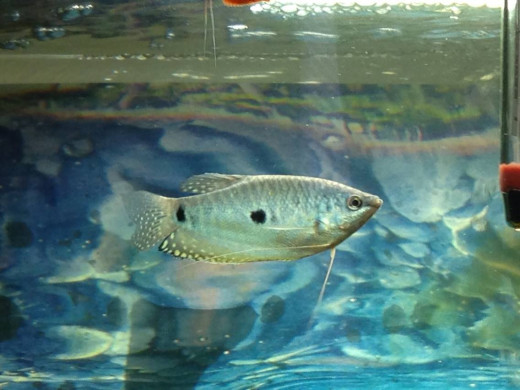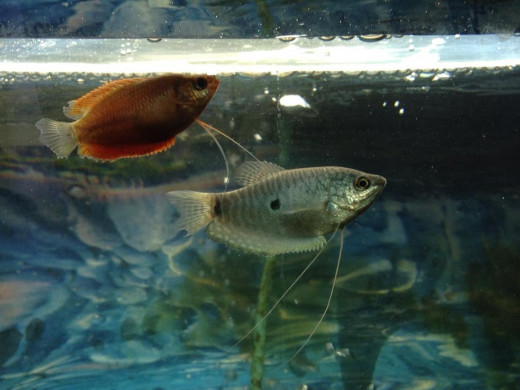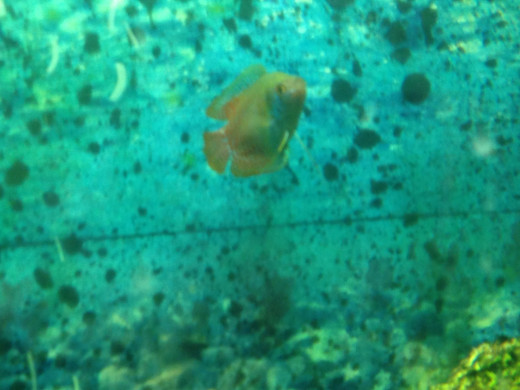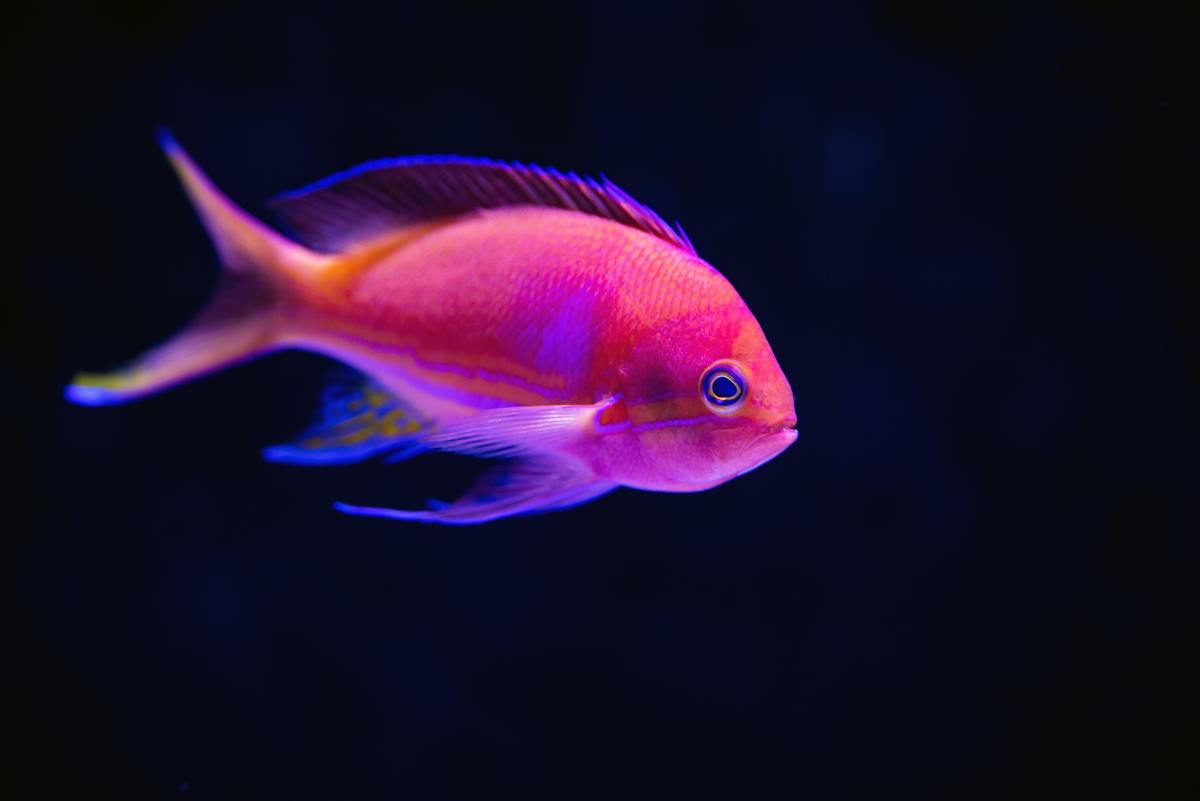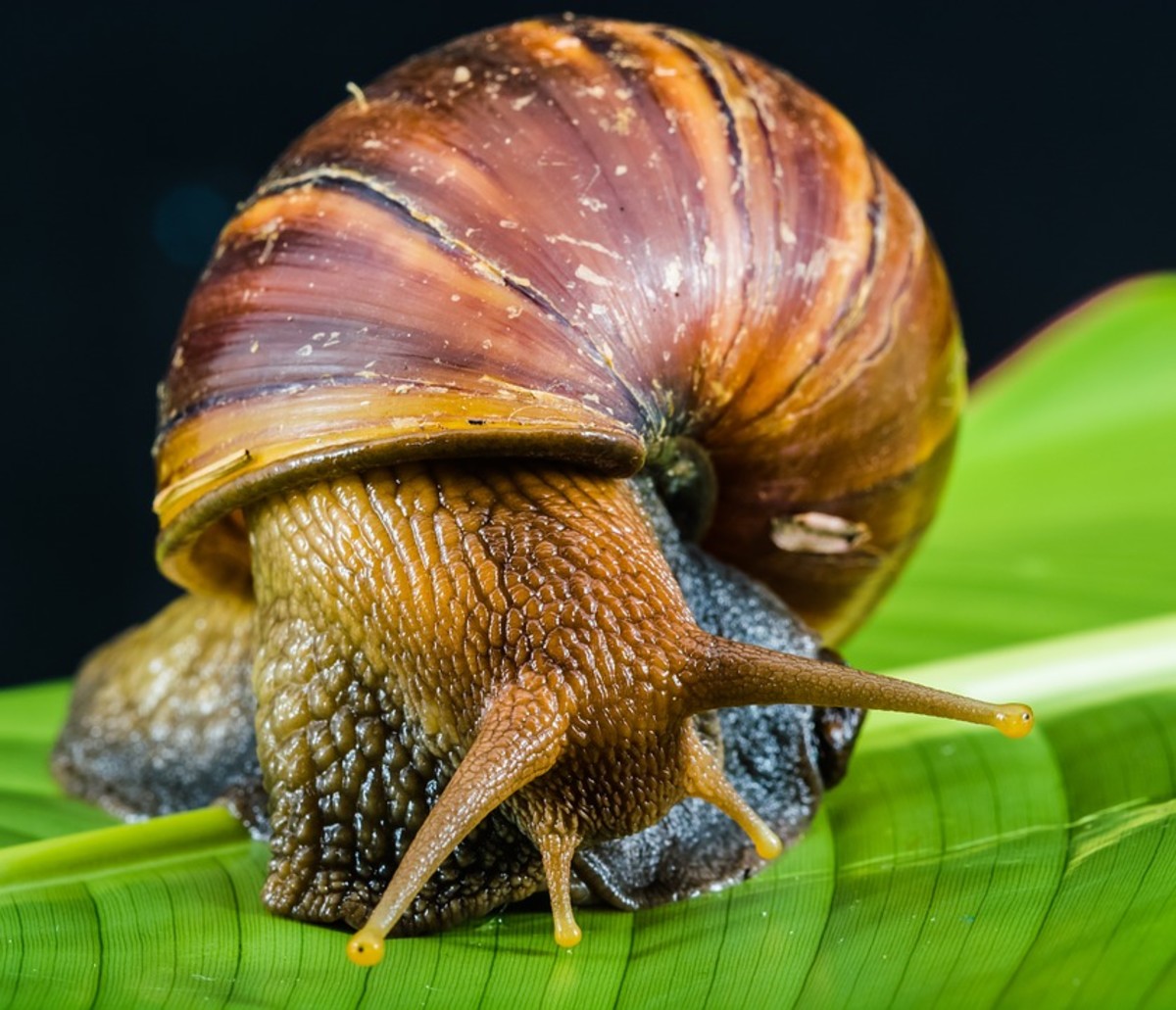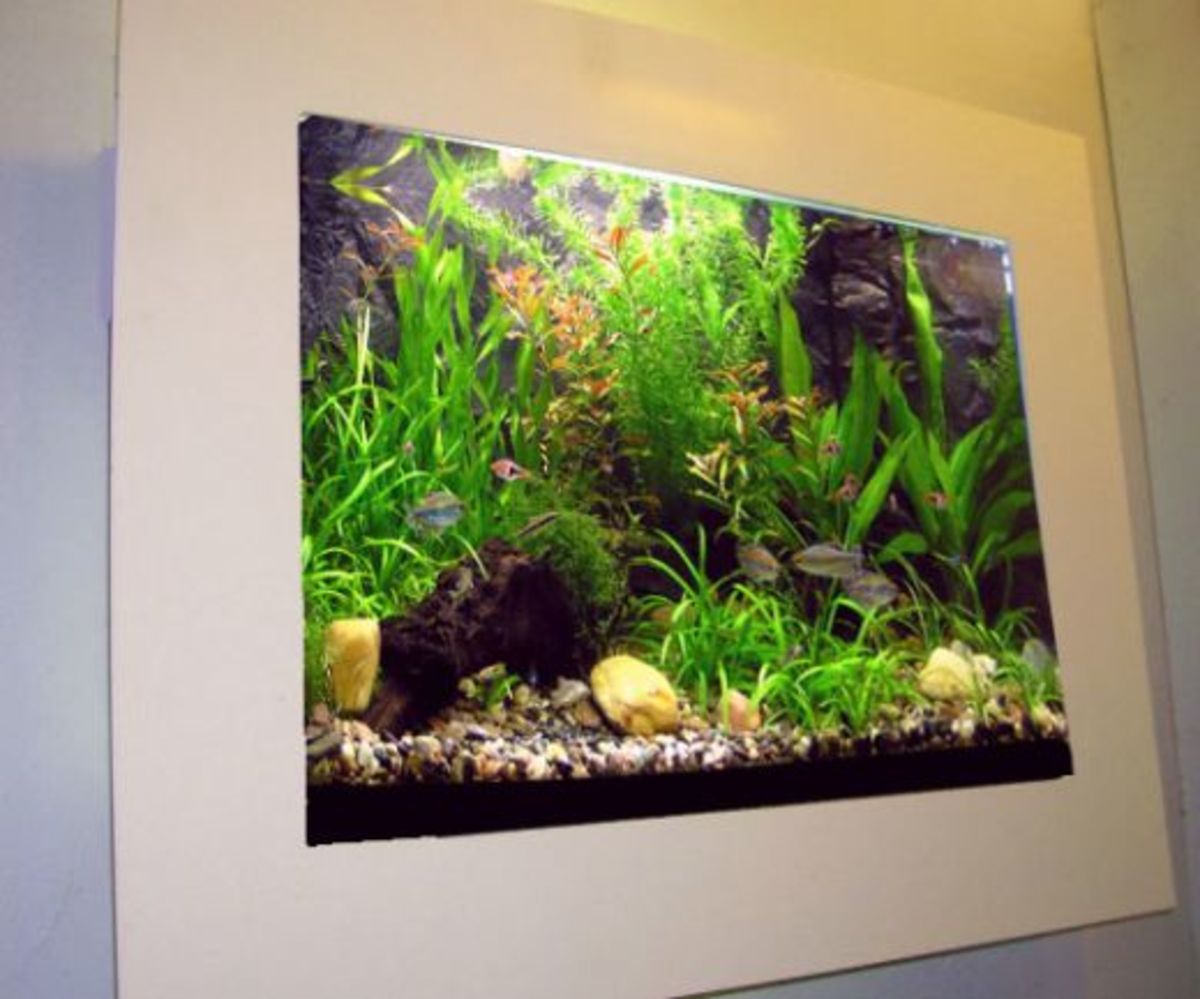Popular Home Aquarium Fish: Gourami
The Basics
Gouramis are beautiful fish. They come in a wide variety of sizes and colors. This is probably why they are so popular amongst hobbyists. Chances are pretty good that if you asked your local pet store what the three types of fish they sell most often their answer will be: tetra, cichlid, and gourami.
Gouramis vary in size from the small dwarf gourami to the gargantuan giant gourami. If you are looking for a fish that will add color and entertainment to your tank then look no further than the gourami. There are a little more than 90 species of fish currently classified as a gourami. They are native to Asia, and can be found from Pakistan to the Korean peninsula. The larger giant gouramis are a food source for many asian cultures.
There are some things that you need to be aware of before you add a gourami to your tank. Aggression and size once fully grown need to be taken into consideration when selecting gouramis. Then, of course, there are the water quality parameters that need to be met for gouramis to live healthy long lives. Gouramis are unique fish that make an excellent addition to an aquarium that meets their needs.
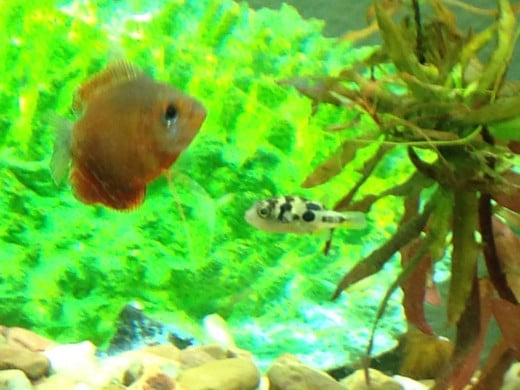
Water Quality Parameters and Temperature
This should go without saying, but I shall say it anyway: gouramis are freshwater fish. In fact these are some of the fish I most often recommend to people who think freshwater fish aren't as pretty and colorful as saltwater fish. In the wild gouramis are found in rivers, lakes, streams, and ponds. These fish are able to tolerate a wide range of temperature and pH. A temperature somewhere between 72 and 82 will suite most of these fish just fine. As for pH, try to keep it between 6.0 and 7.5. These parameters might not seem to wide, but when you compare them to the parameters needed for a discus they are very forgiving. This is one of the reasons hobbyist are able to keep gouramis with many different tank mates. Chances are pretty good that the gourami can handle the water quality needed for more picky fish.
One common mistake new hobbyists make is thinking they don't need to put a heater on their tank. After all, the gourami can handle water that is 72 and you keep your house between 72-75 so therefore the tank water should be about the same. Right? Wrong! This is incorrect thinking, and it will lead to temperature fluctuations between seasons. The temperature of your house is not always constant, also water has a very high specific heat. What does this mean? In simple terms it means that it takes a lot of energy to raise the temperature of water. (Anyone that has taken chemistry in college should be able to tell you that there is a very specific equation to show the exact amount of energy need to raise the temperature of a gallon of water by one degree.) Save yourself the time and stress and get a heater. Heaters are not very expensive and can have different options. Many heaters common on fish store shelves have options ranging from 70-90. The heater will turn on when the water temperature is lower than the set point and turn off once the desired temperature is reached.
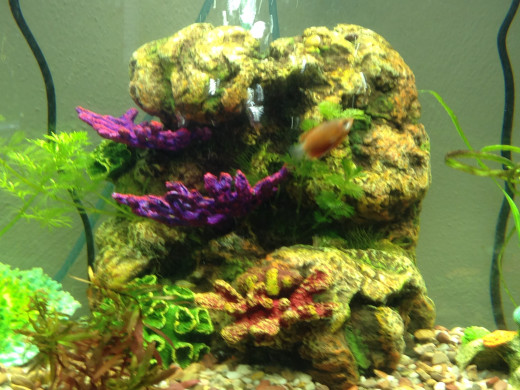
What is your favorite type of gourami?
Special Adaptations
Gouramis and betas have a special organ call the labyrinth organ. This organ is what makes these fish so unique. Over thousands of years these fish have had to develop a way to survive in their native environment. Often these fish are found in warm oxygen-poor bodies of water. When you think about it this makes perfect sense. These fish in live Southeast Asia, a climate that can be very tropical. Wouldn't it make sense that a more tropical environment would have a high evaporation rate? Of course. Long story short but evaporation leads to poor water condition. As a way to survive gouramis and betas developed a way to breathe oxygen at the surface of the water. The labyrinth organ allows these fish to go to the surface of the water and breathe there. This is how they are able to stay alive in oxygen poor environments that would kill other fish.
The labyrinth organ is one of the reasons why you might see your gourami spend a lot of time at the surface of your tank. It doesn't mean that the water in your tank is oxygen poor, these guys just have a special skill and like to use it.
If you do believe that your water might not be oxygenated enough for your fishy friends you do have options available to you. Airstones are easy to set up and add a lot of oxygen to your system. As a bonus they help mix up the water and can be a great way to evenly distribute the heat put off by your heater. Live plants will also increase the amount of dissolved oxygen in your system.
You may have noticed that many gouramis have two very long things coming from the front of their bodies. These are specialized pelvic fins. If you look closely you will see that these fins are located just in front of the anus. You will observe your gourami using these fins to feel around in front of them or even touch each other with them. It is believed that these fins are very sensitive and help the gourami find food. Gourami will even use these 'feelers' to judge distance and help them determine their surroundings. I have found that my gouramis use them the most when the lights are first turned on in the morning and when they are turned off in the evening. Perhaps they have the same issue we do when suddenly bombarded with light or placed into a dark room after being in the light all day.
Type of tank mates can often dictate a fish's behavior. When housed with more aggressive fish don't be surprised if your sweet little gourami suddenly becomes a terror. When housed as the only gourami in a system with other peaceful tank mates you should not encounter any problems with aggression.
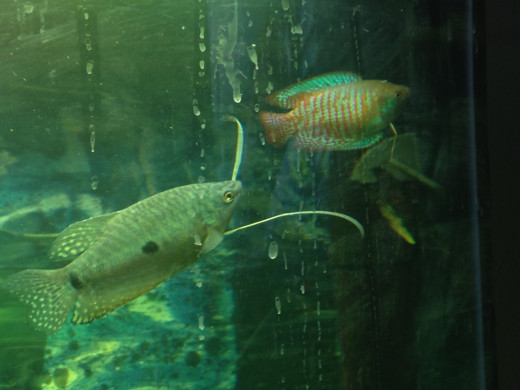
Do Not House Gouramis With
- Bettas
- Angelfish
- Ciclidd
- Discus
- Goldfish
- Platties
- Mollies
Some of these fish do not have the same water quality needs as the gouramis and some of these fish will only cause unnecessary aggression in the tank.
Tank Mates
Gouramis can be very peaceful fish. However, they can also be rather aggressive. Gouramis have been known to go after other gouramis and more flashy fish. It would not be a good idea to house a male beta in the same tank as a gourami. Sometimes gouramis of the same type will be aggressive toward each other. This is most commonly seen in the larger species and not so much with the dawarf gouramis. The kissing gourami is the perfect example of aggressive behavior towards each other. These fish are popular because they appear to kiss. This is actually an aggressive behavior between two males. They are essentially fighting with their mouths.
Usually you are safe getting two of the same type of gourami if they came from the same tank at the pet store. This is not always the case. I have two blue gourami that came from the same tank from my local pet store. They showed no signs of aggression. Once they were acclimated the larger one stared chasing and nipping at the smaller one. They would leave all the other fish alone. The smaller gourami took to hiding all day and only came out when I fed. Once we added more fish to the tank the larger blue became much less aggressive. Currently I have three gourami, two blues and a dwarf fire, in the same system. I plan on adding a neon blue dwarf gourmi to complete my tank.
Tetras, barbs, cory cats, plecos, bala sharks, and many loaches make great tank mates for gouramis. I house mine with freshwater dwarf puffers and a peacock eel and have no problems with my gouramis showing aggression towards them. The puffers might nip at the fins of my gouramis but they stop once the gourami turn tail and chase them.
I would not house gouramis in a tank with very aggressive fish. Betas and ciclidd are a big no-no. Some people are able to have mollies with their gouramis, but I have seen gouramis go after their fins too often to be completely comfortable with them together. The rule of thumb is no really flashy or colorful tank mates.
Many people will advise that you cannot keep two gouramis of the same species together because they will fight. I have found that if your tank is large enough that this is not always the case. A larger tank will give each fish their own space, a territory if you will. Too often people try to get away with putting a lot of fish in small tanks. A 20 gallon might be ok for a dwarf gourami and a couple other fish. But I would never put a blue in anything smaller than a 30.
Decorations
Most aquarium fish like places to hide. They like things to explore. And lets face it, a tank with out decorations is just plain dull. Live plants, fake plants, rocks, driftwood, figurines from the pet store are all great options when it comes to decorating your tank. And who wouldn't want a replica of the Coliseum in their fish tank?
I, personally, am a fan of using live plants in aquariums. I like that they help control excess nitrogen in the system and boost my oxygen levels in the water. But, not all people like the extra care of live plants. That is perfectly fine. If you are going to use fake plants just make sure that there aren't any sharp edges that could hurt your fish. A good tip is to run a pair of pantyhose over the plants if the pantyhose catch and snag chance are so will your fish's fins.
Every pet store sells decorations for fish tanks. I like to give my fish a lot of places to hide if they want to. I try to have a couple of different things along the bottom so that they can each have something to call their own. Fish can get a little territorial over their decorations so you don't just want to put one thing in and call it a day.




Food and Feeding
Gouramis are omnivores. This means they will eat both plants and other animals. You may notice your gourami picking algae off various decorations or even nipping at your plants.
Flake food and pellets are popular options when it comes to choosing food for gouramis. Brine shrimp and bloodworms come in live and frozen and both are good options. You also shouldn't be too surprised if your gourami picks off a few of your smaller snails. Just like betas gouramis will eat snails if given the opportunity.
It is recommended that fish should be fasted every few days. This prevents them from becoming constipated and allows them time to completely digest their food and pass it. To help you remember to fast your fish I recommend picking one day each week to fast them, that way you know if its Sunday they fish are fasted. Be warned your fish will most likely beg for food, but one day of not eating will not hurt them at all.
In the End
Gouramis make great additions to any tank. They add a splash of color and provide hobbyists with endless entertainment. Just like with any other fish you want to make sure that the tank is a safe environment for them. You wouldn't want your fish to live constantly stressed because you wanted to house them with fish that don't have the same water quality needs.
Gourami tend to be very hardy fish. They can survive in a wide range of pH and temperature. When I had a bout of ich in my tank I lost over half of my fish to the ich and secondary infections but the gouramis never had a single parasite on them. Now, I'm not saying they are immune to ich as that would be crazy, but I am saying that they don't get stressed as easily. Not stressing out easily means that your fish will be able to survive most illnesses since illness tends to happen to stressed fish.
I wish you the best of luck with your tank. I hope your fish stay happy and healthy.
© 2013 Alexandria


